Abstract
A new bacterial pathogen of chinook salmon (oncorhynchus tshawytscha) was isolated from fish in Oregon's Rogue River. The bacteria are biochemically and serologically related to strains of Edwardsiella tarda. Initially isolated from chinook salmon, the bacteria were also pathogenic for steelhead and rainbow trout (Salmo gairdneri), and channel catfish (Ictalurus punctatus). The 50% lethal doses for chinook salmon, steelhead trout, and channel catfish injected intraperitoneally and maintained in 18 degrees C water were 4.1 x 10(6), 5.6 x 10(6), and 4.0 x 10(5) respectively. When chinook salmon and rainbow trout were injected intraperitoneally and held in 12 degrees C water, the mean lethal doses were 6.4 x 10(7) and 1.7 x 10(6), respectively. The invasiveness of the organism was low in steelhead trout exposed to the bacteria by the waterborne route. The optimum growth temperature of the bacteria in brain heart infusion broth was approximately 35 degrees C. The guanine plus cytosine content of DNA obtained from E. tarda isolated from salmon was 59 mol%.
Full text
PDF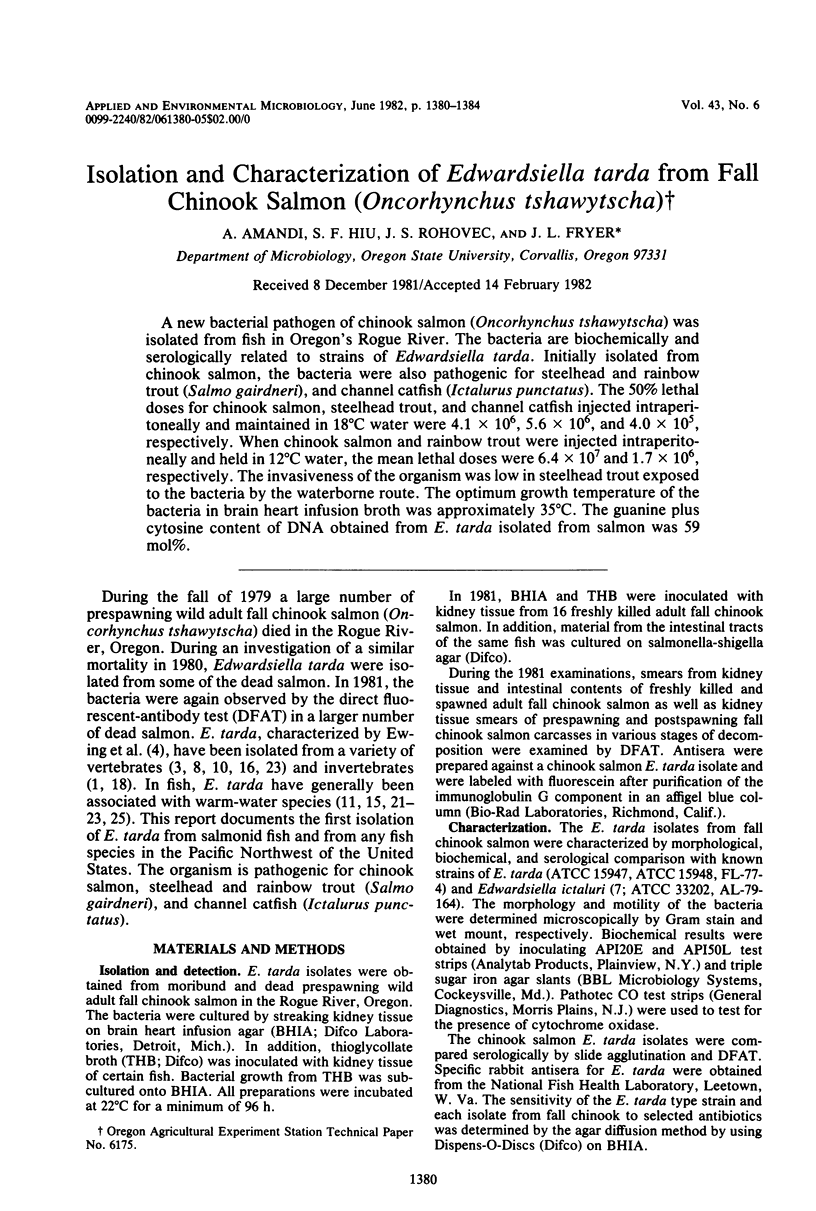
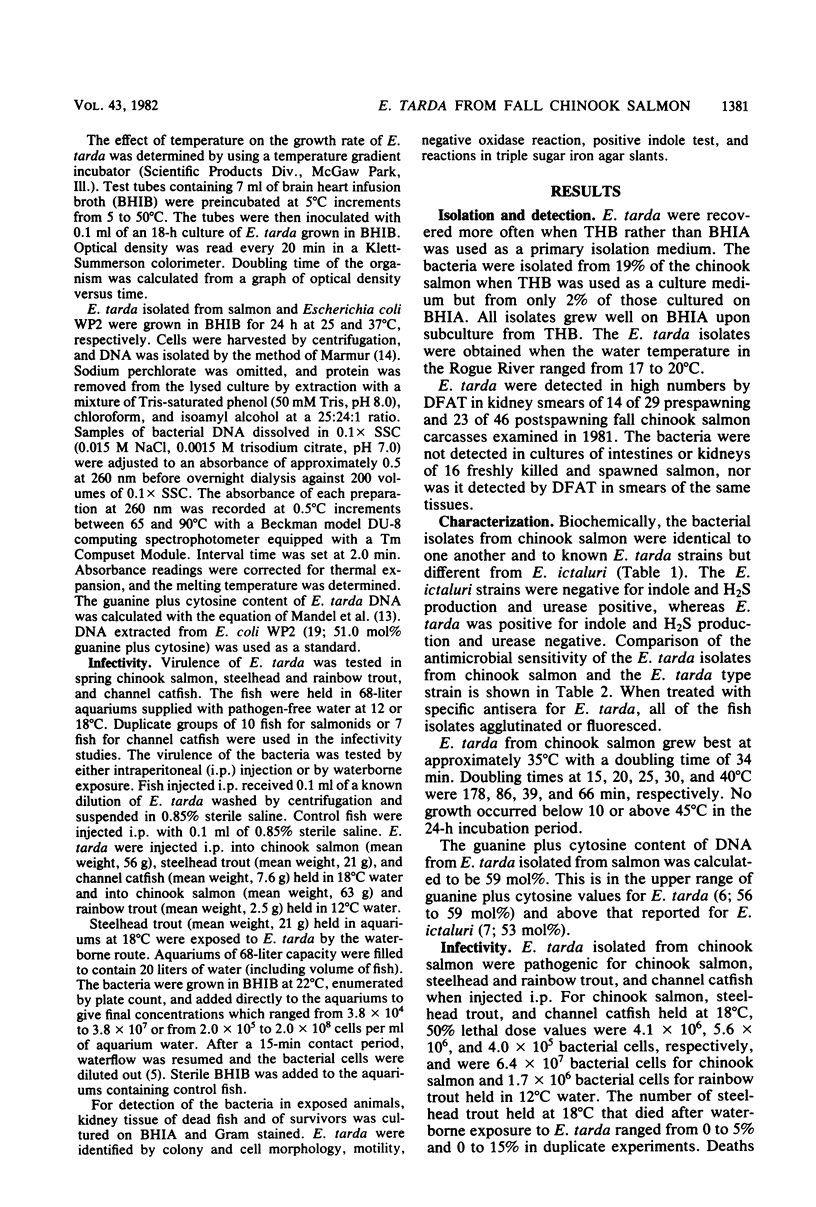
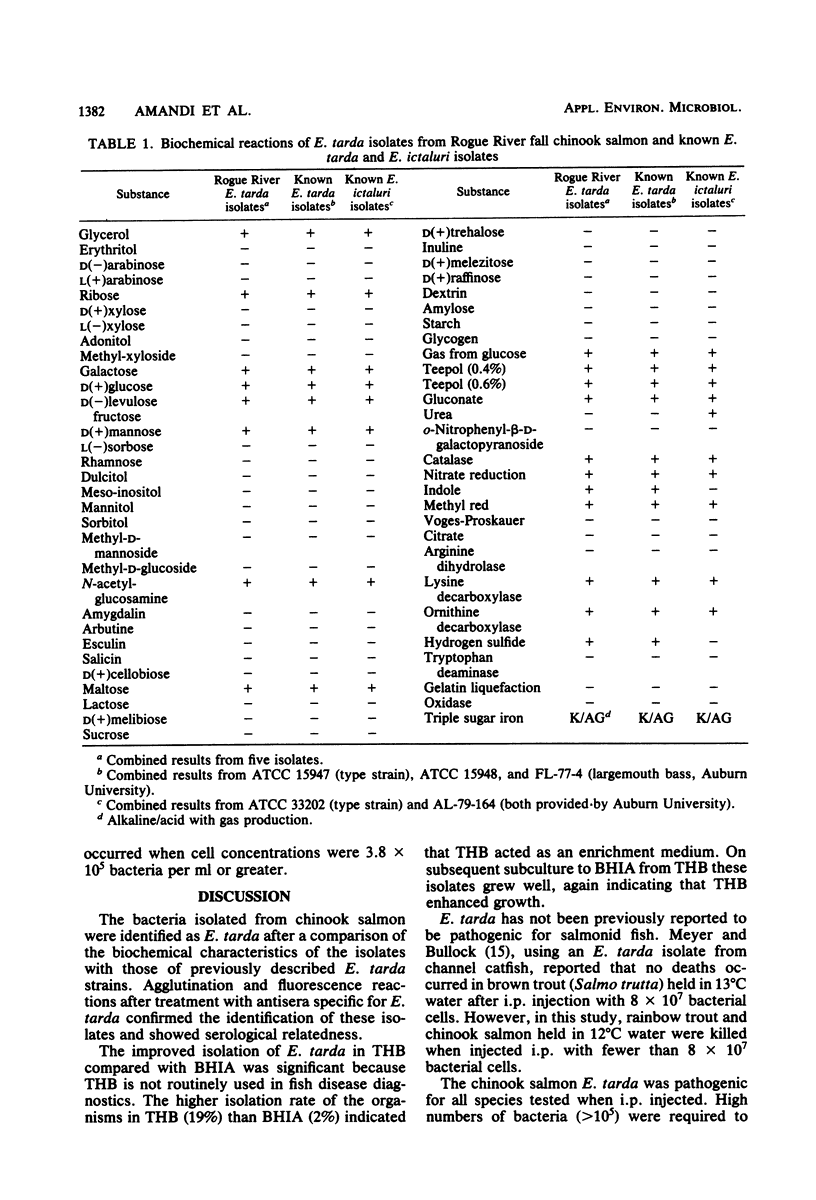
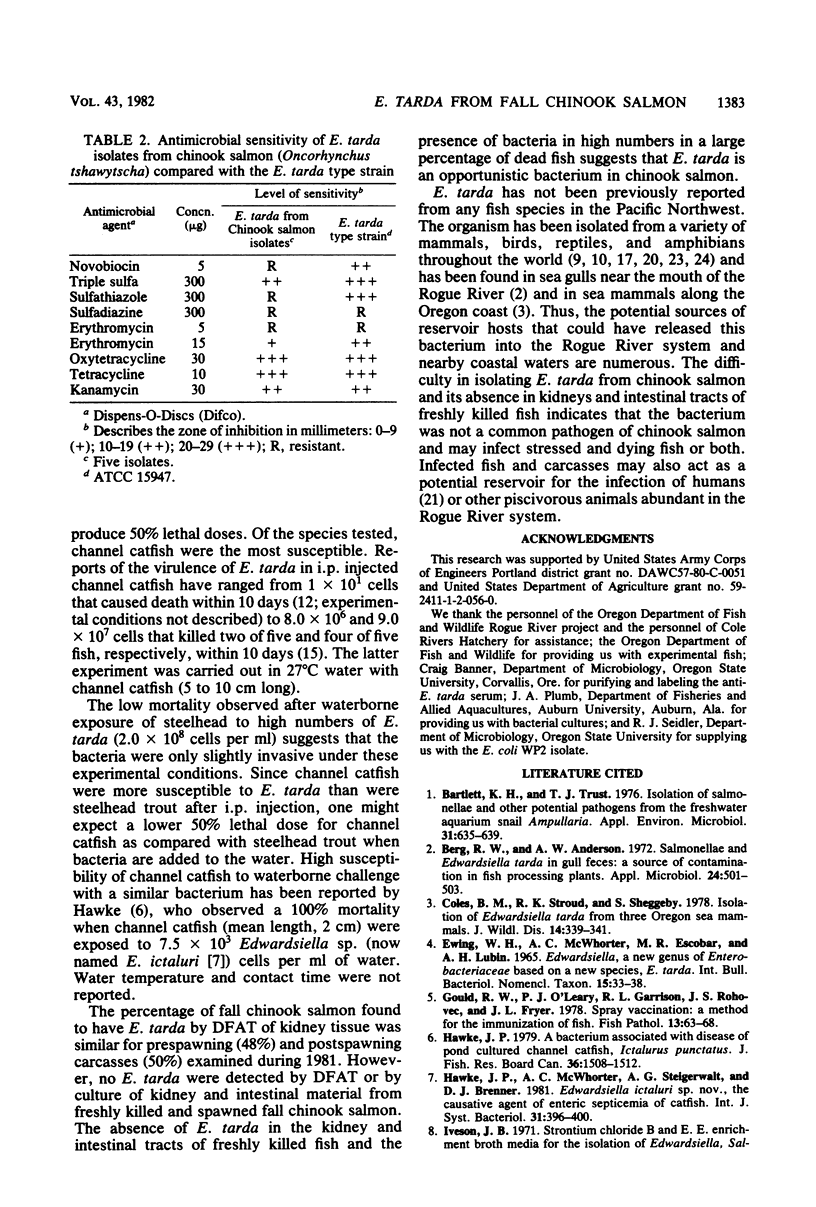
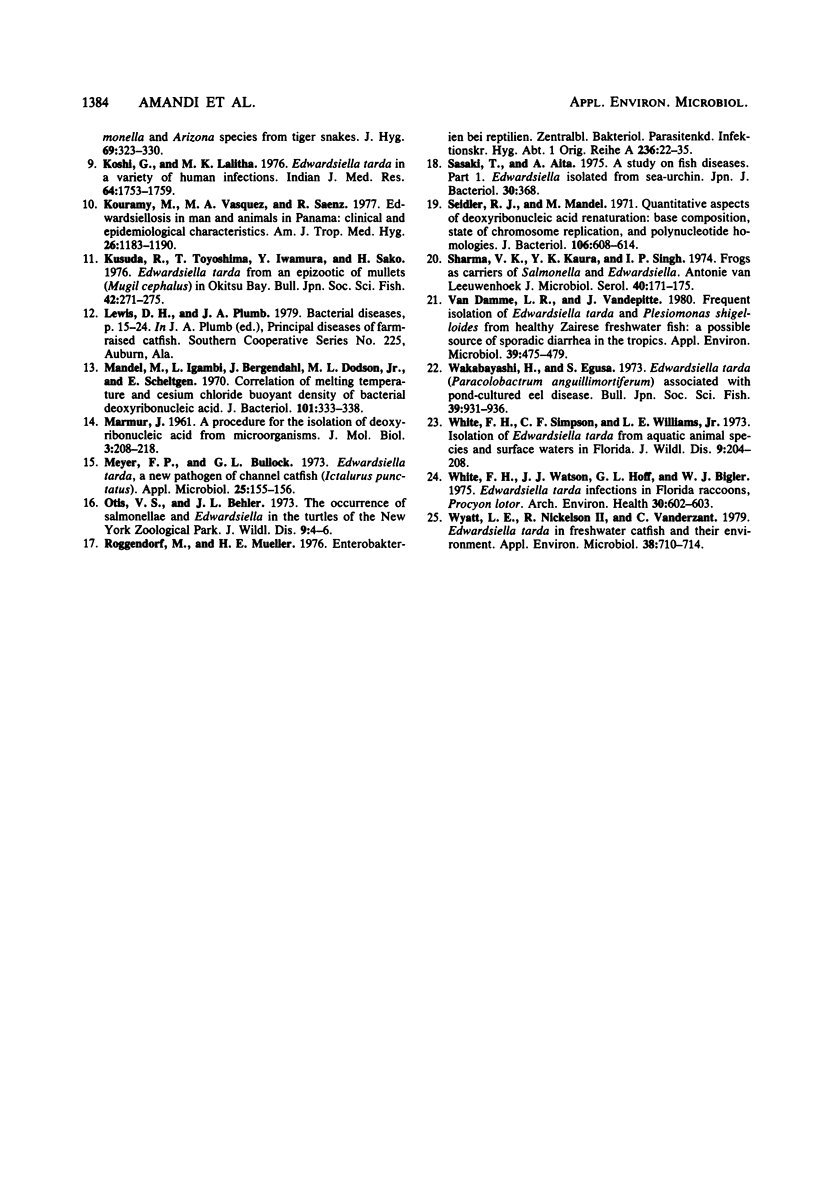
Selected References
These references are in PubMed. This may not be the complete list of references from this article.
- Bartlett K. H., Trust T. J. Isolation of salmonellae and other potential pathogens from the freshwater aquarium snail Ampullaria. Appl Environ Microbiol. 1976 May;31(5):635–639. doi: 10.1128/aem.31.5.635-639.1976. [DOI] [PMC free article] [PubMed] [Google Scholar]
- Berg R. W., Anderson A. W. Salmonellae and Edwardsiella tarda in gull feces: a source of contamination in fish processing plants. Appl Microbiol. 1972 Sep;24(3):501–503. doi: 10.1128/am.24.3.501-503.1972. [DOI] [PMC free article] [PubMed] [Google Scholar]
- Coles B. M., Stroud R. K., Sheggeby S. Isolation of Edwardsiella tarda from three Oregon sea mammals. J Wildl Dis. 1978 Jul;14(3):339–341. doi: 10.7589/0090-3558-14.3.339. [DOI] [PubMed] [Google Scholar]
- Koshi G., Lalitha M. K. Edwardsiella tarda in a variety of human infections. Indian J Med Res. 1976 Dec;64(12):1753–1759. [PubMed] [Google Scholar]
- Kourany M., Vasquez M. A., Saenz R. Edwardsiellosis in man and animals in Panamá: clinical and epidemiological characteristics. Am J Trop Med Hyg. 1977 Nov;26(6 Pt 1):1183–1190. doi: 10.4269/ajtmh.1977.26.1183. [DOI] [PubMed] [Google Scholar]
- Mandel M., Igambi L., Bergendahl J., Dodson M. L., Jr, Scheltgen E. Correlation of melting temperature and cesium chloride buoyant density of bacterial deoxyribonucleic acid. J Bacteriol. 1970 Feb;101(2):333–338. doi: 10.1128/jb.101.2.333-338.1970. [DOI] [PMC free article] [PubMed] [Google Scholar]
- Meyer F. P., Bullock G. L. Edwardsiella tarda, a new pathogen of channel catfish (Ictalurus punctatus). Appl Microbiol. 1973 Jan;25(1):155–156. doi: 10.1128/am.25.1.155-156.1973. [DOI] [PMC free article] [PubMed] [Google Scholar]
- Otis V. S., Behler J. L. The occurrence of Salmonellae and Edwardsiella in the turtles of the New York Zoological park. J Wildl Dis. 1973 Jan;9(1):4–6. doi: 10.7589/0090-3558-9.1.4. [DOI] [PubMed] [Google Scholar]
- Roggendorf M., Müller H. E. Enterobakterien bei Reptilien. Zentralbl Bakteriol Orig A. 1976 Oct;236(1):22–35. [PubMed] [Google Scholar]
- Seidler R. J., Mandel M. Quantitative aspects of deoxyribonucleic acid renaturation: base composition, state of chromosome replication, and polynucleotide homologies. J Bacteriol. 1971 May;106(2):608–614. doi: 10.1128/jb.106.2.608-614.1971. [DOI] [PMC free article] [PubMed] [Google Scholar]
- Sharma V. K., Kaura Y. K., Singh I. P. Frogs as carriers of Salmonella and Edwardsiella. Antonie Van Leeuwenhoek. 1974;40(1):171–175. doi: 10.1007/BF00394564. [DOI] [PubMed] [Google Scholar]
- Van Damme L. R., Vandepitte J. Frequent isolation of Edwardsiella tarda and Pleisiomonas shigelloides from healthy Zairese freshwater fish: a possible source of sporadic diarrhea in the tropics. Appl Environ Microbiol. 1980 Mar;39(3):475–479. doi: 10.1128/aem.39.3.475-479.1980. [DOI] [PMC free article] [PubMed] [Google Scholar]
- White F. H., Simpson C. F., Williams L. E., Jr Isolation of Edwardsiella tarda from aquatic animal species and surface waters in Florida. J Wildl Dis. 1973 Jul;9(3):204–208. doi: 10.7589/0090-3558-9.3.204. [DOI] [PubMed] [Google Scholar]
- White F. H., Watson J. J., Hoff G. L., Bigler W. J. Edwardsiella tarda infections in Florida racoons, Procyon lotor. Arch Environ Health. 1975 Dec;30(12):602–603. doi: 10.1080/00039896.1975.10666788. [DOI] [PubMed] [Google Scholar]
- Wyatt L. E., Nickelson R., 2nd, Vanderzant C. Edwardsiella tarda in freshwater catfish and their environment. Appl Environ Microbiol. 1979 Oct;38(4):710–714. doi: 10.1128/aem.38.4.710-714.1979. [DOI] [PMC free article] [PubMed] [Google Scholar]


